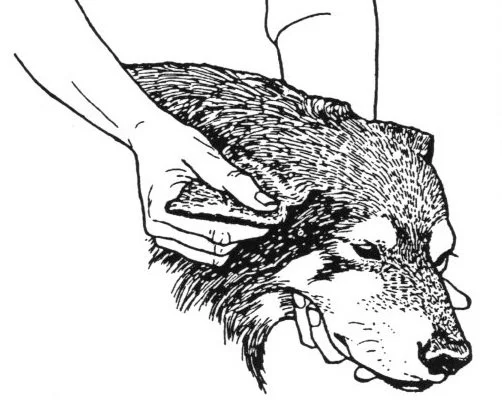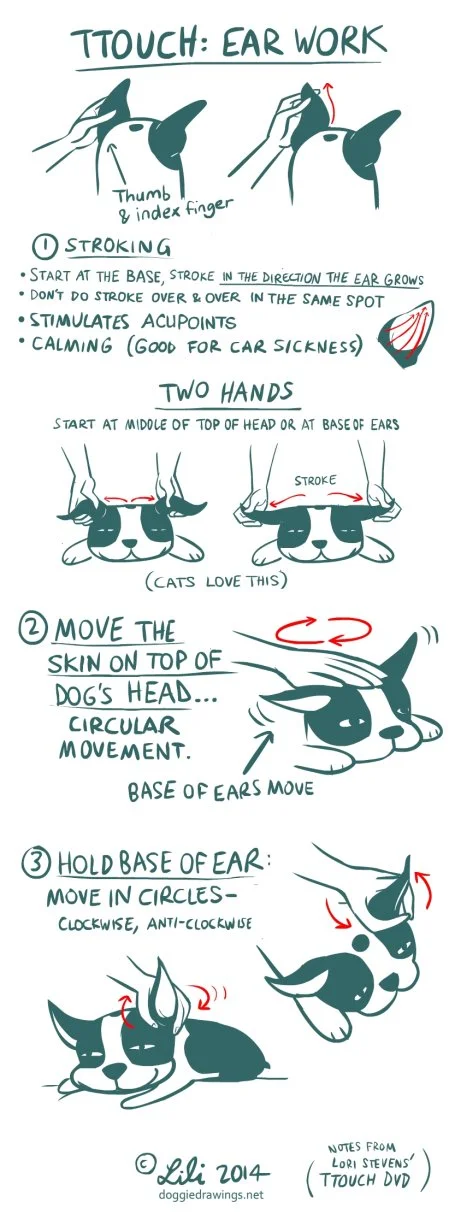Muzzle and Ears: two magic spots
How many times do we find ourselves patting on the head of our dogs, or touching that lovely muzzle that often kisses us impetuously and joyously? How many times do we find ourselves caressing and playing with their ears while we read a book or watch some tv?
Of course they like to have contact with us but … what if we touched them differently?
The skin of our dogs and cats is comparable to a musical instrument which we play always in the same way: we pressing the same keys, mostly randomly, keeping the same “pattern” over and over again. Same rhythm, same speed, same pressure; but our animals’ bodies have many “keys” which we can play graciously with our hands, in several different ways.
Letting these magic keys play through these particular touches allows to enter a deeper communication with our animal at a cellular level and makes their nervous systems receive a different “music” that will be elaborated, integrated and replied to throughout impulses of various genres involving both hormones and neurotransmitters.
Cells, tissues and muscles, therefore posture, emotions and emotional states are involved in a dialogue based on understanding and trust.
Beyond the usual caresses … an other wonderland opens up. The core of the message that these touches send out to the cells is reminding them their perfect functioning, as the wise Intelligent Nature intended. If we don’t get in the way obstructing the Intelligence of Nature but instead we co-operate with it, we become real participants and co-creator of health and wealth.
Ears have many different acupuncture points; if we start from just under the eye, and then go around the ear at its very base, down through the neck to the shoulder all down to the paw we are following the Triple Warmer Meridian that is in charge of various activities one of which is digestion.
We can touch the ears sliding on them, moving them circularly or making circular touches ON them.
When we do the slides we always want to follow the shape of the ear which means that if you have a german shepherd you will go upwards, starting from the base, keeping it between our thumb and second finger, proceeding the way up to the very tip of the ear included. After the first slide we move a bit and we do that again until the whole area of the ear will have been covered with parallel slides. It’s very important not to do two slides in a row on the same spot otherwise it could result in a bothering feeling for our companion animal.
If the dogs has soft ears whose natural shape falls down as labradors’ or cockers’, we will do just the same kind of maneuver but supporting the auricle with our palm while we slide the ear between our thumb and second finger.
We can do the slides one ear at a time or both at the same time.
A comfortable position will help us having a straight and soft wrist so the energy can flow. If we were in a twisted position our wrist would not be as soft, making the very touch quite stiff whose benefits would drop.
When we do the ear work, whether it be slides or circular TTouches it’s always very important to include both the base and the tip of the ear. At the base we find the Triple Heater meridian passing by, while the tip is directly connected with the emotional states of shocks: if we work here we’re going to have a very big impact on the release of traumas, fears and shocks.
Ears can be worked on in several ways as mentioned before. To do the circular touches ON them, we will be supporting first the ear’s auricle with our palm while the thumb moves the skin (on the external part)with a circular motion in a circle and a quarter pattern, meaning that we copy the motions of the clock’s minutes’ hand moving for 1 hour and a quarter. In this case (and in all circular TTouches) it’s fundamental to move the skin and not just to graze it to get the effect we’re aiming to. Clockwise motion is here suggested.
An other way to work the ears is to grab them gently one at a time, at the base, and moving them holding them, always in a circle and a quarter pattern motion, then adding a pause and repeat, both clockwise and anti clockwise motions are possible here.
Ear work is useful for:
-dogs that have car sickness and digestive problems
-helping dogs to discharge the anesthesia faster and more efficiently after a surgery or an examination
-calming phobic dogs that are anxious, traumatized or shocked
-dogs that are hypersensitive to noises (bells ringing, thunders, televisions etc..)
-reactive dogs that are keen barkers ( in this very specific case the whole area that includes muzzle, neck and shoulder is rather tense and the ear work helps to release the tensions there)
Let’s see now the other magic spot: the muzzle. Wondrous part, humid nose, mobile lips… they curl, they lift. Just think about how many things our dogs do with their muzzle: they sniff and gather a huge variety of smells and scents. Each trace has an incredible amount of precious data, info and… stories. Yes, complex smells can tell actual stories: who passed by, where did they go before, who they met, how’s their health and so on..
Canine friends use the muzzle also to bark (both in playful situations and in various difficult situations), to howl, to bite, to cry, to drink, to eat, to kiss, to pick up toys, to play fetch, to take care of their offspring, to take care of themselves, of their own or their loved ones’ bodies.
There are really many activities covering wide different fields, and all are experienced throughout the muzzle so it naturally follows that this is a highly potent and rich zone to work with.
We can interact with the mouth of the dog sliding our thumb and second finger inside ON the upper and lower gums, having previously damped our fingers either with water or with the same saliva of the dog.
We can also slide our second and third fingers externally starting from the nose following the shape of the muzzle. Soft and conscious caresses.
The hand that’s not TTouching will support the chin, letting the dog to lean it on our palm allowing him to release excess weight, therefore relaxing during the sessions. If the dog wasn’t at ease at the start giving you his chin you can try to push very lightly against it and then releasing the contact allowing to engage the action-reaction effect; eventually the dog shall oppose to your pressure lowering the head and finally lying his chin on your palm.
When we’re supporting the chin with one of our hands, the other one will do some circular TTouches around the muzzle. We might want to use the tips of our fingers, with the first segment or with the first two segments of our fingers, and these would respectively be the Raccoon TTouch, the Clouded Leopard TTouch and the Lying Leopard TTouch. (in the Tellington TTouch every touch has the name of an animal)
Mouth work is useful for:
-dogs that struggle to deal with their emotions
-avid barkers
-objects biters
-puppies that are teething
How does mouth work actually.. works?
The mouth is an area directly linked to the limbic part of the brain which is related to emotions and learning.
We don’t want to repress certain behaviours but instead we want to free the dog from the chains of dysfunctional schemes that run automatically and take the power over the dog. Barking is something natural and useful but when it goes out of control it becomes a compulsory stress which the dog is subdued to. The more it goes on the more it is reinforced as it produces hormones that strengthen that pattern; so if this kind of barking arises helping the dog to quit it will help him neatly to stop reacting and start choosing what it’s best to do.
Trying these TTouches on our own body, arms, mouth, neck, belly etc gives us the feeling that our animals experience when they receive these body manipulations. So don’t be shy, let’s try!
Speed, pressure and tempo can be varied and changed from time to time or even during the same session according to the dogs’ feedback.
I want to underline that the aim of the circular TTouches is to move the skin and not to press into the muscles, so the pressure will be very light and gentle and every single TTouch can last from less then a second up to 3 seconds.
Safety first: here I mentioned dogs that are prone to biting. It’s warmly discouraged putting our hands IN the mouths of dogs that bite easily and that might have already bitten some humans. Usually dogs give many signs before biting, but if they’re not listened to for several times, they will eventually they bite without any warning. Every time a dog bites he will reinforce and strengthen this action. Being able to avoid this will help both the potential victim and the dog himself as he will be taken off from this problematic habit.
HERE the video of dogs’ olfactory system

